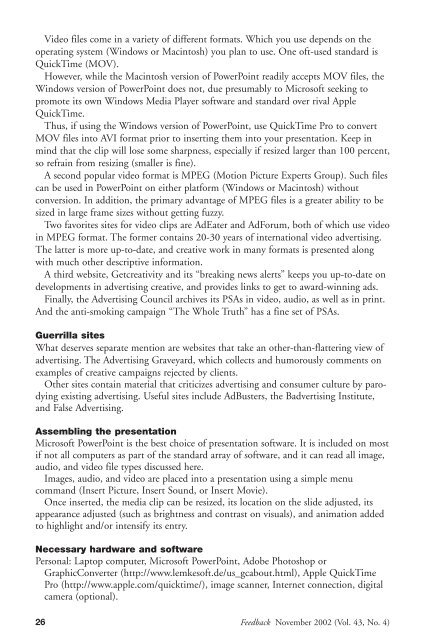Feedback November 2002 (Vol 43 No 4)
Feedback November 2002 (Vol. 43, No. 4) - Broadcast Education ...
Feedback November 2002 (Vol. 43, No. 4) - Broadcast Education ...
You also want an ePaper? Increase the reach of your titles
YUMPU automatically turns print PDFs into web optimized ePapers that Google loves.
Video files come in a variety of different formats. Which you use depends on theoperating system (Windows or Macintosh) you plan to use. One oft-used standard isQuickTime (MOV).However, while the Macintosh version of PowerPoint readily accepts MOV files, theWindows version of PowerPoint does not, due presumably to Microsoft seeking topromote its own Windows Media Player software and standard over rival AppleQuickTime.Thus, if using the Windows version of PowerPoint, use QuickTime Pro to convertMOV files into AVI format prior to inserting them into your presentation. Keep inmind that the clip will lose some sharpness, especially if resized larger than 100 percent,so refrain from resizing (smaller is fine).A second popular video format is MPEG (Motion Picture Experts Group). Such filescan be used in PowerPoint on either platform (Windows or Macintosh) withoutconversion. In addition, the primary advantage of MPEG files is a greater ability to besized in large frame sizes without getting fuzzy.Two favorites sites for video clips are AdEater and AdForum, both of which use videoin MPEG format. The former contains 20-30 years of international video advertising.The latter is more up-to-date, and creative work in many formats is presented alongwith much other descriptive information.A third website, Getcreativity and its “breaking news alerts” keeps you up-to-date ondevelopments in advertising creative, and provides links to get to award-winning ads.Finally, the Advertising Council archives its PSAs in video, audio, as well as in print.And the anti-smoking campaign “The Whole Truth” has a fine set of PSAs.Guerrilla sitesWhat deserves separate mention are websites that take an other-than-flattering view ofadvertising. The Advertising Graveyard, which collects and humorously comments onexamples of creative campaigns rejected by clients.Other sites contain material that criticizes advertising and consumer culture by parodyingexisting advertising. Useful sites include AdBusters, the Badvertising Institute,and False Advertising.Assembling the presentationMicrosoft PowerPoint is the best choice of presentation software. It is included on mostif not all computers as part of the standard array of software, and it can read all image,audio, and video file types discussed here.Images, audio, and video are placed into a presentation using a simple menucommand (Insert Picture, Insert Sound, or Insert Movie).Once inserted, the media clip can be resized, its location on the slide adjusted, itsappearance adjusted (such as brightness and contrast on visuals), and animation addedto highlight and/or intensify its entry.Necessary hardware and softwarePersonal: Laptop computer, Microsoft PowerPoint, Adobe Photoshop orGraphicConverter (http://www.lemkesoft.de/us_gcabout.html), Apple QuickTimePro (http://www.apple.com/quicktime/), image scanner, Internet connection, digitalcamera (optional).26<strong>Feedback</strong> <strong><strong>No</strong>vember</strong> <strong>2002</strong> (<strong>Vol</strong>. <strong>43</strong>, <strong>No</strong>. 4)
















